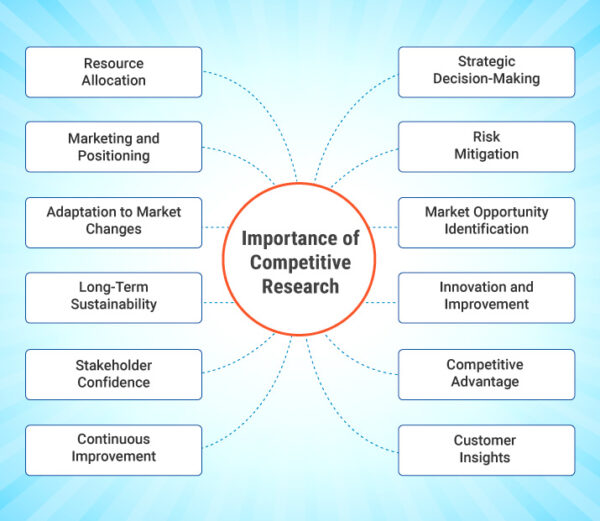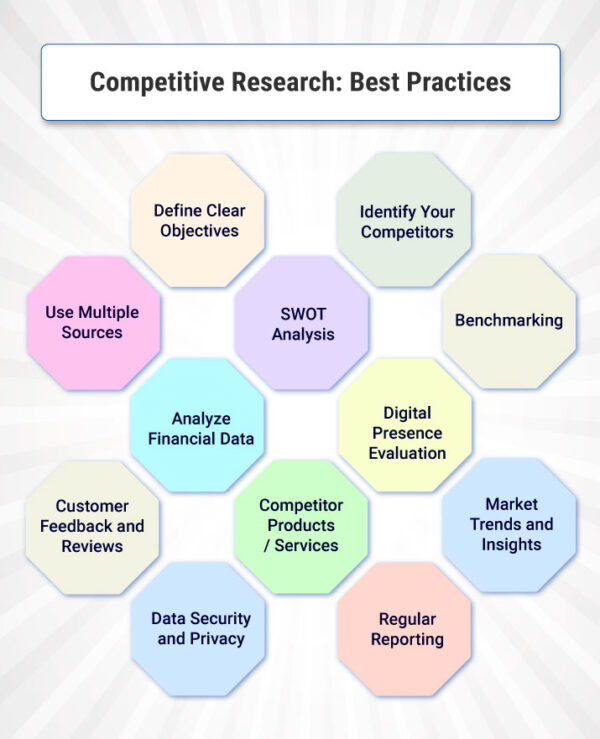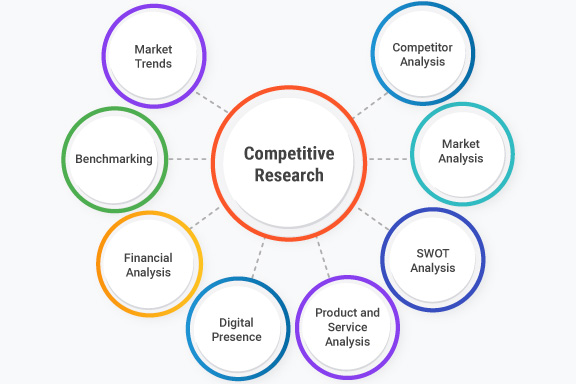Table of Contents
What is Competitive Research?
Competitive research, also known as competitive intelligence or competitive analysis, is defined as the process of gathering, analyzing, and interpreting information about your competitors and the competitive landscape in your industry. The primary goal of competitive research is to gain insights and knowledge that can help you make informed business decisions, refine your strategies, and gain a competitive advantage.
Here are the key elements of competitive research:
- Competitor Analysis: This involves identifying and studying your direct and indirect competitors. Direct competitors are businesses that offer similar products or services to the same target audience, while indirect competitors may provide different solutions but still address the same customer needs.
- Market Analysis: Understanding the broader market in which you operate is crucial. This includes evaluating market size, growth trends, customer demographics, and other relevant market dynamics.
- SWOT Analysis: A SWOT analysis (Strengths, Weaknesses, Opportunities, Threats) is a common framework used in competitive research to assess your competitors’ strengths and weaknesses, as well as the opportunities and threats they face in the market.
- Product and Service Analysis: Examine your competitors’ offerings in detail, including product features, quality, pricing, and positioning. This helps identify areas where you can differentiate your own products or services.
- Digital Presence: Evaluating your competitors’ online presence, including their websites, social media activity, digital marketing efforts, and content strategy.
- Customer Feedback: Gathering and analyzing customer feedback, reviews, and comments related to your competitors. This can provide insights into customer preferences, pain points, and satisfaction levels.
- Financial Analysis: If possible, review financial statements and reports to assess your competitors’ financial health and performance. This can help you understand their growth, profitability, and stability.
- Benchmarking: Comparing your business’s performance metrics (such as sales, revenue, customer acquisition cost, etc.) with those of your competitors. Benchmarking can highlight areas where you excel and areas that need improvement.
- Market Trends: Keeping an eye on industry trends, emerging technologies, and shifts in consumer behavior can help you anticipate changes in the market and adjust your strategies accordingly.
- Regulatory and Legal Factors: Identifying any regulatory or legal factors that may impact your competitors’ operations or your own business in the industry.
Competitive research is an ongoing process that requires regular updates and adjustments as market conditions and competitors’ strategies evolve. The insights gained from competitive research can inform various aspects of your business, including product development, marketing strategies, pricing decisions, and overall business planning. By staying informed about your competitors and the market, you can make more strategic decisions and maintain a competitive edge.
Importance of Competitive Research

The importance of competitive research cannot be overstated in today’s highly competitive business environment. It plays a pivotal role in shaping the success and longevity of a company. Here are several key reasons why competitive research is crucial:
- Strategic Decision-Making: Competitive research provides the foundation for informed and strategic decision-making. By understanding your competitors, you can make adjustments to your business strategy that exploit their weaknesses or capitalize on their strengths.
- Risk Mitigation: It helps in identifying potential risks and threats in advance, allowing you to take proactive measures to mitigate them. This proactive approach can save your business from unexpected challenges and disruptions.
- Market Opportunity Identification: By studying your competitors, you can identify untapped market opportunities that they may have overlooked. This allows you to position your business to fill gaps in the market effectively.
- Innovation and Improvement: Analyzing your competitors can inspire innovation within your organization. You can learn from their successes and failures, leading to the development of ideation and approaches that set you apart.
- Competitive Advantage: Gaining insights into your competitors’ strengths and weaknesses enables you to refine your own strengths and exploit their weaknesses, ultimately giving you a competitive advantage in the market.
- Customer Insights: Competitive research can reveal valuable insights about your target audience. By understanding why customers choose your competitors, you can tailor your offerings to better meet their needs and preferences.
- Resource Allocation: It helps in optimizing resource allocation. You can focus your time, budget, and efforts on areas that are most likely to yield positive results, rather than spreading resources thinly across all aspects of your business.
- Marketing and Positioning: By analyzing your competitors’ marketing strategies and positioning, you can craft more effective marketing campaigns and messages that resonate with your target audience.
- Adaptation to Market Changes: Competitive research keeps you attuned to changes in the market, such as shifts in customer preferences, emerging technologies, or new market entrants. This awareness allows you to adapt your strategies accordingly.
- Long-Term Sustainability: In the long run, competitive research contributes to the sustainability of your business. It helps you stay relevant and responsive to market dynamics, which is essential for surviving and thriving over time.
- Stakeholder Confidence: Investors, partners, and stakeholders often appreciate a well-informed and strategic approach. Demonstrating that you have a clear understanding of your competitive landscape can instill confidence in those who support your business.
- Continuous Improvement: Competitive research is not a one-time task; it’s an ongoing process. Regularly monitoring your competitors and the market ensures that you stay agile and adaptable in a rapidly changing business world.
Competitive research is a fundamental element of effective business management. It equips you with the knowledge needed to make informed decisions, seize opportunities, mitigate risks, and maintain a competitive edge. By investing time and resources in competitive research, businesses can position themselves for sustained growth and success in a dynamic and competitive marketplace.
Learn more: What is Research?
15 Competitive Research Methodologies
Effective competitive research requires a structured methodology to ensure that you gather and analyze information systematically. Here’s a step-by-step methodology for conducting competitive research:
1. Define Your Objectives
Start by clarifying your research objectives. What precise data are you aiming to collect? Are you focused on a particular aspect, such as product features, pricing, or marketing strategies?
2. Identify Your Competitors
Generate an exhaustive inventory of both your direct and indirect competitors. Direct competitors offer similar products or services to the same target audience, while indirect competitors may address the same customer needs through different means.
3. Gather Information
Collect data from various sources. This can include:
- Publicly Available Information: Look for information on your competitors’ websites, social media profiles, press releases, annual reports, and other publicly accessible documents.
- Industry Reports: Access industry-specific reports and studies that may provide insights into your competitors and market trends.
- Customer Reviews and Feedback: Read customer reviews, comments, and feedback on review websites, social media, and forums.
- Trade Shows and Conferences: Attend industry events or monitor online coverage of trade shows where your competitors may showcase their products or services.
- Competitor’s Products or Services: If possible, purchase or use your competitors’ products or services to assess their quality and user experience.
4. SWOT Analysis
Perform a SWOT analysis (Strengths, Weaknesses, Opportunities, Threats) for each of your key competitors. This framework helps you identify their advantages and vulnerabilities.
5. Product or Service Analysis
Analyze your competitors’ offerings, including features, quality, pricing, and positioning. Compare these aspects to your own products or services to identify gaps or areas for improvement.
6. Digital Presence
Evaluate your competitors’ online presence. This includes their website design, content quality, social media activity, and digital marketing strategies. Note any unique selling points (USPs) they emphasize.
7. Customer Feedback Analysis
Analyze customer feedback, reviews, and comments related to your competitors. Look for recurring themes, customer complaints, and areas of satisfaction or dissatisfaction.
8. Financial Analysis
If financial information is available, review your competitors’ financial statements to assess their financial health, growth trajectory, and profitability.
9. Benchmarking
Compare your own performance metrics (e.g., sales, revenue, market share) with those of your competitors. Benchmarking helps you identify where you excel and areas that need improvement.
10. Market Trends and Insights
Stay updated on industry trends, emerging technologies, and shifts in consumer behavior. Understanding the broader market context is crucial for strategic decision-making.
11. Organize and Document Findings
Create a structured document or database to organize and store your research findings. This makes it easier to reference and share the information with relevant stakeholders.
12. Regular Updates
Competitive research is an ongoing process. Continuously monitor your competitors and the market to stay informed about changes and new developments.
13. Ethical Considerations
Always adhere to ethical guidelines when conducting competitive research. Avoid any unethical or illegal practices, such as corporate espionage.
14. Data Security
Ensure that you handle competitive research data securely to protect sensitive information.
15. Actionable Insights
Finally, translate your research into actionable insights. Use the knowledge gained to inform your business strategies, whether it’s product development, marketing campaigns, pricing adjustments, or other decisions.
By following this structured competitive research methodology, you can gather valuable insights that inform your business decisions and help you stay competitive in your industry. Remember that competitive research should be an ongoing practice to adapt to changing market dynamics effectively.
Learn more: What is Consumer Research?
Competitive Research: 18 Best Practices

Effective competitive research is essential for businesses to gain a competitive edge and make informed strategic decisions. To ensure that your competitive research efforts yield valuable insights, here are some best practices to follow:
- Define Clear Objectives: Start by establishing clear research objectives. What specific information are you seeking to gather, and how will it inform your business decisions?
- Identify Your Competitors: Generate a thorough list of both your direct and indirect competitors. Ensure you cover both established and emerging players in your industry.
- Use Multiple Sources: Gather information from various sources, including public records, online data, industry reports, customer feedback, and primary research. Depending solely on one source could result in biased or incomplete information.
- Maintain Ethical Practices: Always adhere to ethical guidelines when conducting competitive research. Avoid any unethical or illegal practices, such as corporate espionage or data breaches.
- Stay Updated: Competitive research is an ongoing process. Continuously monitor your competitors and the market to stay informed about changes and new developments.
- Focus on Relevant Data: Concentrate on gathering data that directly relates to your objectives. Avoid information overload by excluding irrelevant details.
- SWOT Analysis: Perform a SWOT analysis for each competitor to assess their Strengths, Weaknesses, Opportunities, and Threats. This structured framework helps organize your findings.
- Benchmarking: Compare your own performance metrics (e.g., sales, revenue, market share) with those of your competitors. Benchmarking helps you identify where you excel and areas that need improvement.
- Analyze Financial Data: If available, analyze financial statements and reports to assess your competitors’ financial health, growth trajectory, and profitability.
- Digital Presence Evaluation: Evaluate your competitors’ online presence, including their websites, social media activity, digital marketing strategies, and content quality.
- Customer Feedback and Reviews: Analyze customer feedback, reviews, and comments related to your competitors. Look for recurring themes and areas of customer satisfaction or dissatisfaction.
- Competitor Products/Services: Study your competitors’ products or services in detail, including their features, quality, pricing, and positioning. Compare these aspects to your own offerings.
- Market Trends and Insights: Stay updated on industry trends, emerging technologies, and shifts in consumer behavior. Understanding the broader market context is crucial for strategic decision-making.
- Data Security and Privacy: Ensure that you handle competitive research data securely to protect sensitive information. Comply with data privacy regulations.
- Collaboration: Encourage cross-functional collaboration within your organization. Different teams can offer unique perspectives on competitors and market trends.
- Actionable Insights: Translate your research into actionable insights. Use the knowledge gained to inform your business strategies, whether it’s product development, marketing campaigns, pricing adjustments, or other decisions.
- Regular Reporting: Create regular reports summarizing your competitive research findings and distribute them to relevant stakeholders within your organization.
- Feedback Loop: Establish a feedback loop to incorporate ongoing competitive insights into your decision-making processes and strategic planning.
By following these best practices, you can conduct competitive research effectively and use the insights gained to develop informed strategies that give your business a competitive advantage in the market.
Learn more: What is Market Research Analysis?
Most Recent Blogs
Explore the latest innovation insights and trends with our recent blog posts.










